Microeconomics ECON0013
1/123
There's no tags or description
Looks like no tags are added yet.
Name | Mastery | Learn | Test | Matching | Spaced |
|---|
No study sessions yet.
124 Terms
homotheticity (definition?)
Under the Marshallian, how do we determine homotheticity if given…
ICs?
Utility fxn?
MRS?
Demand?
constant MRS along rays from origin
if within indifference curve function: q1 and q2 have a common scaling
Utility fxn is homogeneous u(kx) = ku(x)
MRS is only a fxn of ratio x1 and x2. NO tack-ons
homogenous to income only, i.e. the fxn is y times some function of p’
quasilinearity, definition?
Identification for Marshallian under
ICs
Utility fxn
MRS
Demand
(QUASILINEARITY WRT Q1)
constant MRS along y=c or x=c
ICs: find the slope (MRS)
Utility fxn has q1 “tacked on”
MRS only depends on q2
Demand FOR Q2 depends only on p’ without regard to y
quasilinearity (identification from marshallian demand)
if quasilinear wrt good 1, then the Marshallian demand for GOOD 2 will depend on some function of p1 and p2 alone, WITHOUT regard to income
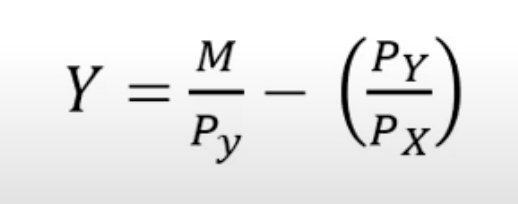
hicksian demand
aka. compensated demand
q* = g(v,p)
obtained by FOCs from expenditure minimisation (to reach a required level of utility)
homogeneity of Hicksian demand
since q*=g(v,p) it is obvious that increasing prices have no effect on the quantity needed to reach a certain u. This is because u does not depend on p.
Homogeneity of degree zero to prices
homotheticity property of Hicksian
function of prices * utility

quasilinearity property of Hicksian (what happens when utility changes)
(if wrt q1) similar to Marshallian where adding to budget will increase only the good 1 consumption and leave others unchanged
Hicksian: adding to utility will increase good 1 consumption in order to reach the required utility

indirect utility fxn (definition / identity with Hicksian / homogeneity)
sub in marshallian demands into utility function
v(y,p) - now spits out a utility (this is the same utility from the expenditure MINIMISATION)
note that the Hicksian evaluated at the indirect utility bundle is equal the Marshallian demand g(v(y,p),p) = f(y,p)
homogenous degree zero in prices and income

expenditure function (definition / identities)
the cost of the Hicksian bundle
note that the marshallian evaluated at the cost minimisation bundle is equal to the hicksian f(c(v,p),p) = g(v,p)

expenditure function (is it inc/dec in p? inc/dec in v?, homogeneity? _____ in prices?)
increasing in p and v. makes sense since increasing either will incur a higher cost
homogeneous of degree one in prices. doubling prices doubles expenditure.
concave in prices
indirect utility fxn (properties, homogeneity)
v(y,p) is increasing in y and decreasing in p.
homogeneous degree zero in price and income. doubling both price and income will leave the utility bundle unchanged
'adding up’ property of the cost function
the cost function is the sum of all (p*q) whereby q is obtained from the Hicksian
derive shepherd’s lemma from the cost function
taking the ‘adding up’ definition of cost
then, take derivative wrt price of good j = g(v,p) + SUM[ (pi) dg/dpj ]
the pi can be replaced with the Lagrangean FOC mu*du/dqi
which can be shown to make the second term equal zero
so dc/dpj = gj(v,p)
The derivative of the cost function wrt p is the Hicksian demand
Write the formula for roys identity and how can we derive it
-dv/dpi / dv/dy = fi(y,p)
Write the Lagrangian.
By Envelope Theorem, dL/dy = dv/dy = lambda
dL/dp = dv/dp = -lambda*q
Dividing the two equations yields our Roy’s identity result
how are indirect utility and cost functions related, mathematically
v(c(v,p), p) = v, whereby c(v,p) = y
c(v(y,p), p) = c
What is the Slutsky eqn for?
derive the Slutsky compensated eqn again
Slutsky relates the price effects on Marshallian with Hicksian.
First take the compensated demand fxn g, and differentiate wrt price
g = f(c(v,p),p)
dg/dp = df/dp + df/dc*dc/dp
dg/dp = df/dp + df/dy*dc/dp
dg/dp = df/dp + df/dy*(g(v(y,p) ,p)) ← Shepherds Lemma
dg/dp = df/dp + df/dy* (f(y,p)) ← equality of Hicksian/Marshallian
Hicksian demands - does it satisfy negativity? Why?
yes, satisfies negativity. this is because it is the derivative of the cost function. the cost function is concave in prices → implies negativity (substitution effect)
As long as WARP is satisfied
slutsky symmetry
by shepherd’s lemma, the two pairings gi/pj and gj/pi are both equal to each other in the slutsky eqn
dgi/dpj = dgj=dpi

property of compensated cross-prices
the effect of increasing price i on good j is equal to the effect of increasing price j on good i
this is by the law of slutsky. complementarity and subsitutability are symmetric
which can only be applied to hicksian and not marshallian
adding up and the hicksian
sum of p*g = c(v,p)
homogeneity of marshallian
homogeneous of degree zero to price and income (doubling both leaves marshallian qty unchanged)
integrability
if demand functions:
satisfy adding up
homogeneity
negativity
symmetry
OR - the demand was derived from a utility maximisation / expenditure minimisation from convex ICs
OR - the demand was taken using shepherds lemma or roys identity
how do the utility maximisation problem, expenditure minimisation problem, marshallian demand, hicksian demand, indirect utility function and expenditure function all connect together?
diagram
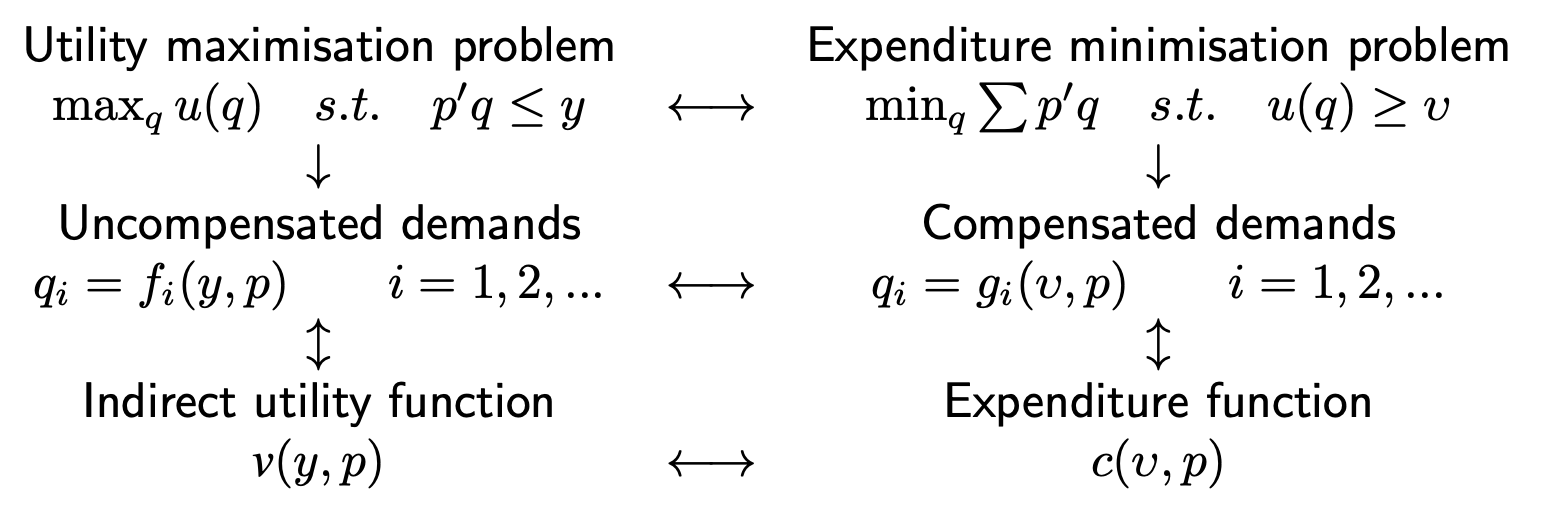
homothetic preferences and impact on indices?
Homotheticity means that the cost function is v*f(p)
So it cancels out in the Konus.
Therefore the Konus is independent of utility (regardless of whether you’re rich or poor it affects you the same way)
change in consumer surplus - how is it found
‘lost’ area of the marshallian demand from old to new price (by integration)
compensated variation
expenditure function evaluated at the old utilities: whereby c(v0,p1) - c(v0,p0)
this is equivalent to the ‘lost’ area in the original Hicksian (at v0) where we integrate p0 to p1
equivalent variation
expenditure function evaluated at the new utilities: whereby c(v1,p1) - c(v1,p0)
this is equivalent to the ‘lost’ area in the new Hicksian (at v1) where we integrate p0 to p1
true cost of index
aka. T or Könus index
= c(v,p1) / c(v,p0)
when does the dependence on v disappear in the Könus index? what, then, is the value returned by the index?
what happens to KOnus if prices increase and preferences are homothetic?
when prices double, triple,etc. change by a common scalar
the index will return the scalar. (2 for doubling)
Konus scales proportional to the price change
Laspeyres index
L = sum(p1q0)/sum(p0q0)
evaluates quantity bundles at original prices
multiply by p0/p0 to get the alternate form: sum(w0 p1/p0)
Paasche index
P = sum(p1q1)/sum(p0q1)
evaluates quantity bundles at new prices
multiply by p1/p1 to get the alternate form: 1/sum(w1 p0/p1)
Envelope Theorem of cost function and indirect utility fxn
dC/dv = dL/dv = lambda
dC/dp = dL/dp = q (Hicksian)
dv/dy = dL/dy = lambda
dv/dp = - lambda * q1
Prove Roy’s identity
Use the Envelope Theorem to write out
dv/dy = lambda
dv/dp = -lambda*q
Divide 2nd by 1st eqn
net demand
z = q - w
where q is the gross demand (amount consumed)
w is the endowment
labour supply budget constraint
total value of consumption and leisure = full income (endowed income + total value of endowed time)
pc + wh = y + wT
substitution / income effect of price increase for…
demand without an endowment
demand with an endowment
labour supply
subs eff must be -. Inc eff generally - but if inferior good, will be + . Giffen good iff total effect is pos
subs eff must -, inc eff can be either + or - dep on buyer/seller
subs eff must +, inc eff must +, total eff is ambiguous
endowment income effect (define? and derive it please)
Definition: df/dY - MEASURES how changing endowment affects demand
Derivation:
Write out the equation for endowed demand. I.e. net demand = q - ω = φ
d(φ)/d(p) = ω(df/dY) + df/dp (By chain rule)
Using Slutsky’s eqn for df/dp, we get the required result: d(phi)/d(p) = dg/dp - z(dphi/dY)
where df/dY is our endowment income effect
steps for solving labour supply problems
replace c in the utility fxn with y+wL/p (this comes from the budget constraint pc=y+wL) and replace h with T-L
take FOCs wrt L and solve for L.
what are engel curves?
as income increases, what happens to demand and what happens to the share of expenditure
plots f against y, or w against y
tells you whether good is inferior or normal, or luxury/necessity
how do we find the final value of the Laspeyres or Paasche index?
Find the Marshallian demand
Using the formulas for Laspeyres or Paasche, plug in for q.
Simplify.
L or P should be functions of just p at the end (so you could plug in theoretical numbers and solve)
how do we solve Labour Supply questions?
Write down what we are trying to maximise and what the restrictions are. (Maximising utility fxn u(c,h), with restriction of c=y+wL)
Be sure to replace L with T-h. Remember that we want all h on the LHS and multiplied by its ‘cost’
Use MRS=MRT to find the optimal h
Find L
what is the only case where preferences are both homothetic and quasilinear? What is the form of the utility fxn in this case?
If the indifference map contains parallel straight lines to an axis.
This happens when goods are perfect substitutes. e.g. U(x,y) = ax+by
MRS & Homotheticity
Can there be extra terms tacked on?
To check if preferences are homothetic, look at the MRS. It should be a function of only the ratio of q1 and q2. It does not matter if there are extra terms tacked on.
q1/q2 + 8 is homothetic.
Cobb-Douglas demand function shortcut
q1 = (α/α+β)(y/p1)
q2 = (β/α+β)(y/p2)
Along the income expansion path, the MRS is…
constant.
MRT does not change (budget set remains same) so the optimality condition MRS=MRT must hold. And so implies MRS is constant.
Homothetic preferences and budget share?
Regardless of income, the budget share of goods remains the same.
Quasilinear preferences (wrt good 1): what is the income elasticity for good 1? For good 2?
income elasticity for good 1 = 1
income elasticity for good 2 = 0
What is the only case in which there might be multiple solutions that solve optimality MRS = MRT?
If there are corner solutions. Which only happen if the budget set or indifference curves are not convex (one of the above)
how do we know if a demand is integrable (3 options to check)
derived from utility maximisation or cost minimisation from well-specified utility functions
derived from shepherds lemma or roy’s identity using well-specified functions
they satisfy negativity, adding up, symmetry, and homogeneity
What does SARP imply
In two good scenario, SARP implies WARP which implies negativity, homogeneity, and symmetry are met
compensating variation
the loss in CS integrating from p to p’ (following a price increase) evaluated at the initial level of utility
equivalence variation
the loss in CS integrating from p to p’ (following a price increase) evaluated at the final level of utility
Hicksian demand of a quasilinear good (wrt 1)
Only depends on prices of good 1. It does not depend on prices of good 2 nor the level of utility
How does the existence of endowments change the Marshallian? The Hicksian?
The Marshallian goes up beacuse the existence of endowments increases the budget set, so you can reach a higher utility.
The Hicksian stays the same. This is because you are still trying to minimise given a fixed utility.
Income and subsitution effect signs for labour supply
if an increase in w → increase in L what does this imply
what if increase in w → decrease in L?
are FLIPPED because it is a supply
for the demand of leisure, income eff must be + (leisure is a normal good), subs must be -
for the supply of labor, subs must be +, income eff can be -
s.t. an increase in w → increase in L implies the substitution effect dominates
if an increase in w → decrease in L this means income effect dominates
what does the utility fxn for a economy under intertemporality look like
there is a discount factor on the 2nd period

intertemporal elasticity of substitution (def?)
what does a higher elasticity imply
and how do we calculate it
measures how responsive the slope of IC is to changes in interest rate
dln(c1/c0) / dln(1+r)
higher elasticity implies more responsive, so the utility fxn is less concave
we calculate it from the FOC (MRT=MRS) where we can replace c1/c0 with y and 1+r with x
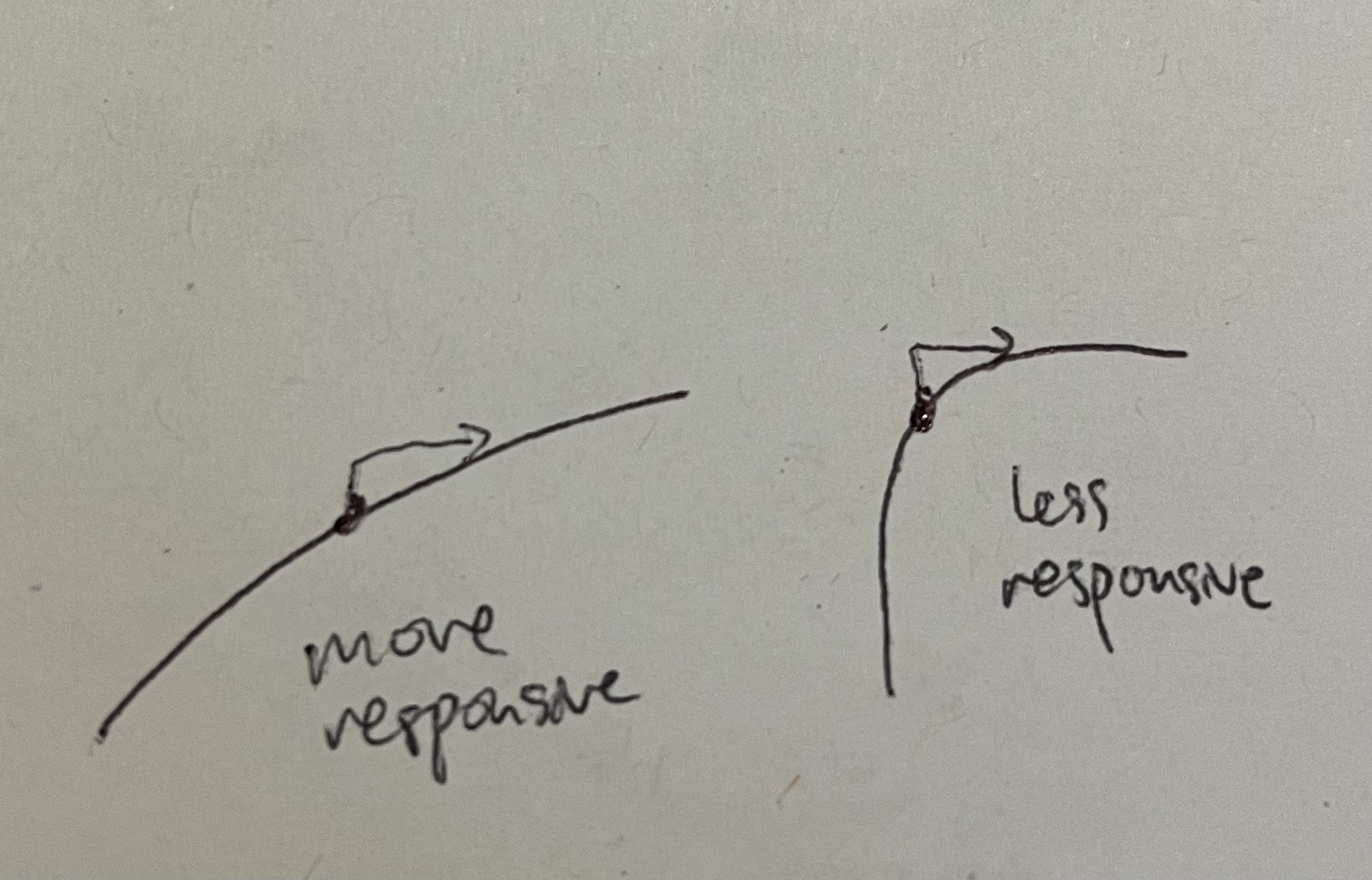
Derive the optimal conditions for the insurance choice problem and hence draw the budget constraint
good (no theft) c0 = A - Kp
bad (theft) c1 = K - Kp
A is wealth, K is amount insured, p is the premiums paid
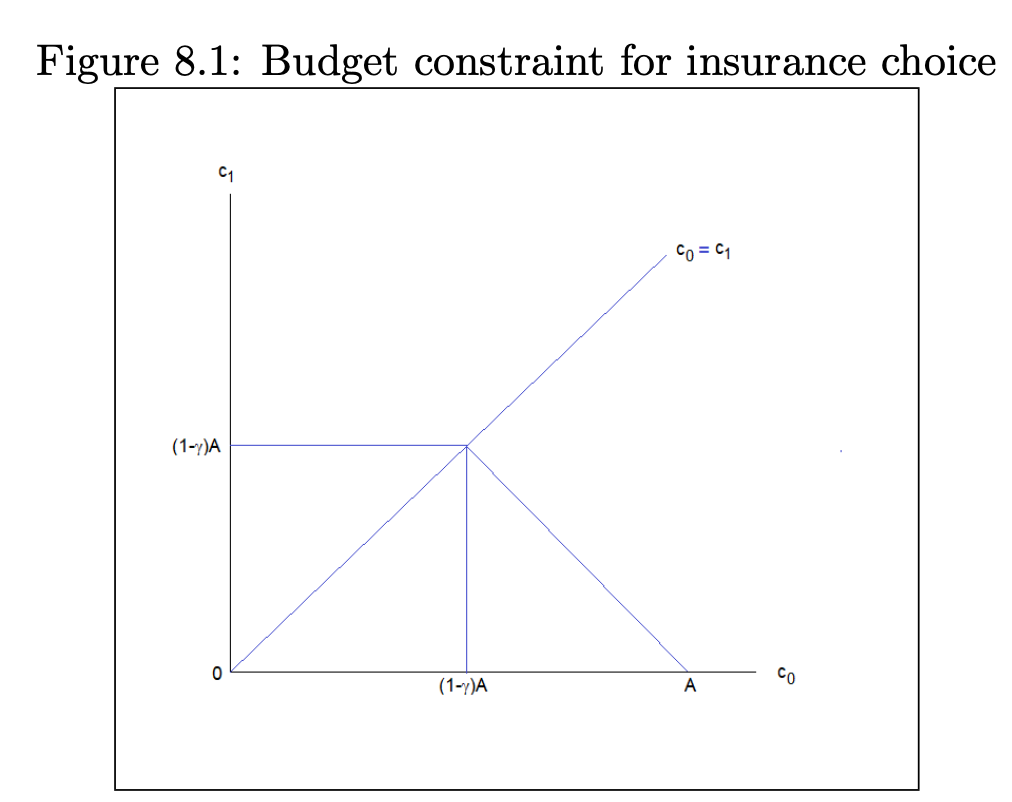
Insurance / betting / tax-evasion problem. What variable do we eliminate to derive the budget constraint?
Eliminate the value that you want to know.
For example: insurance case eliminate the amount to insured
Betting eliminate the amount to bet
Tax-evasion eliminate the amount to evade
Sure thing principle
If there are two different lotteries with different payoffs corresponding to three possibilities, and lottery #1 is chosen,
Then in another case of two different lotteries with different payoffs, lottery #3 should be chosen. It is a case of induction.
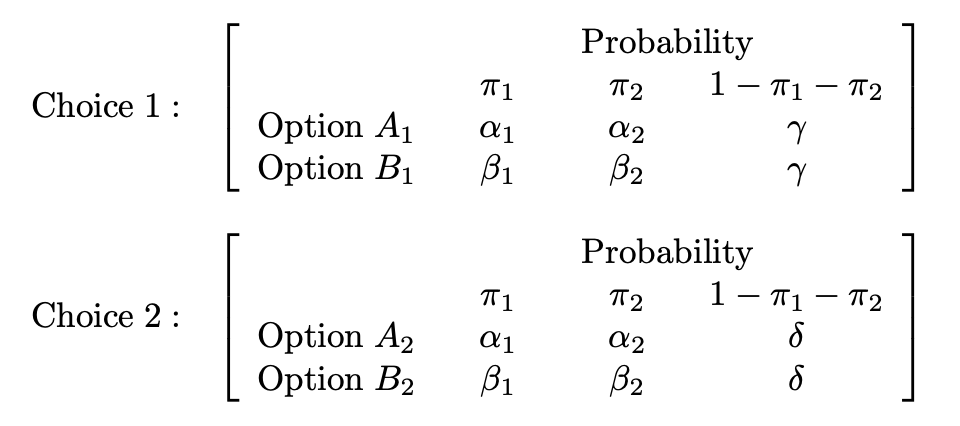
How does risk aversion relate to the concavity of the utility function?
The more concave it is, the more risk averse the person is.
Actuarially fair
If the probability of getting into an accident (pi) is equal to the premiums paid (gamma), then the person will choose to insure the full wealth.
When does underinsurance happen?
If the insurance premium (gamma) is larger than the probability of getting into an accident (pi)
Allais paradox
Counterargument to the “Sure Thing Principle”
It shows from empirical evidence that this principle is violated, for example in the case of preferring certainty in one case (when there is a small chance of losing a lot) and preferring risk in another (when there is a small chance of gaining a lot)
What if insurance conditions are better than fair?
Depends on the laws in the country. Assuming you cannot borrow money to buy more insurance then the point chosen is still full insurance, but utility is not maximised as there is an imaginary possibility of gaining more from borrowing and then purposefully choosing to be in the bad state.
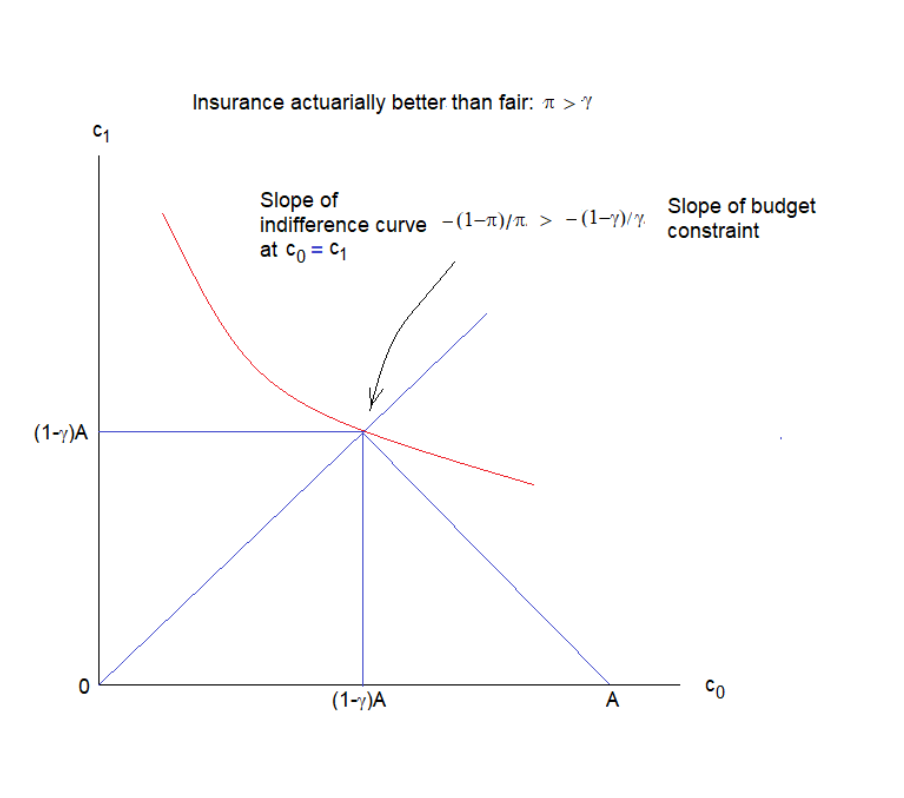
Derive the optimal conditions for the betting problem and hence draw the budget constraint. Hint: Write out the expected utility.
good (win) c1 = (A-K) + K(1+r) = A+Kr
bad (lose) c0 = A - K
where A is your initial wealth, K is your bet, r is the return from winning
The expected utility function is…
E(U) = πv(c1) + (1-π)v(c0)
= πv(A+Kr) + (1-π)v(A-K)
Optimal conditions:
Take the derivative of E(U) wrt K and evaluate at K=0.
dE(U)/dK = πrv’(c1) - (1-π)v’(c0)
v’(A) [πr - (1-π)]
This marginal benefit must be larger than zero,
Hence: πr - (1-π) > 0, so πr > (1-π)
Derive the optimal conditions for the tax-evasion problem and hence draw the budget constraint
“good” (evade tax) c0 = Y - (T-D)
“bad” (get caught) c1 = Y - T - Df
D is amount of tax evaded
f is a fine paid on the amount of tax evaded
T is the amount of tax you’re meant to pay
Y is your income
income expansion path (draw an example)
the path traced out by demands as y increases
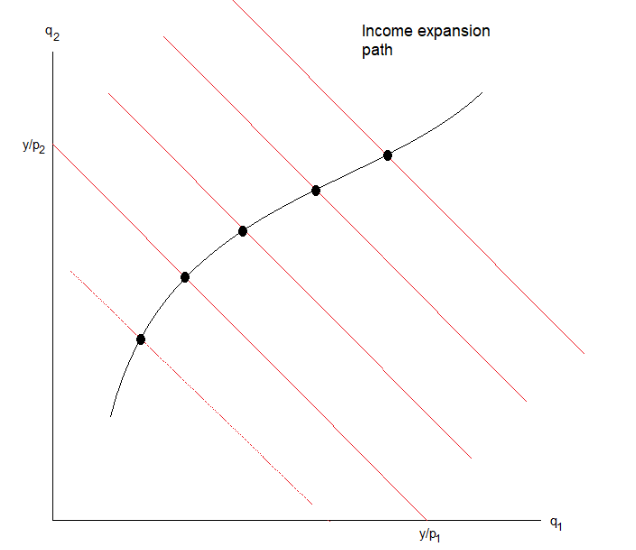
luxury
budget share of a good, w, rises with total budget
necessity
budget share of a good, w, falls with total budget
offer curve (draw an example)
the path traced out by demands as pi increases
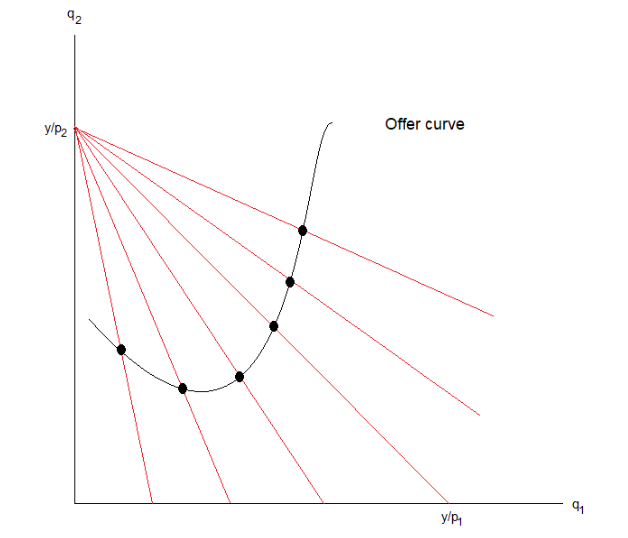
Normal vs Giffen good (Tell me one thing abt Giffen goods and the Slutsky)
Own price elasticity - when it is negative it is a normal good. When it is positive it is a Giffen good
Giffen goods - the income effect dominates the substitution effect in the Slutsky
Price elastic good (Draw an example of price increase and price elastic good)
The own-price elasticity is less than -1. If budget share falls with price
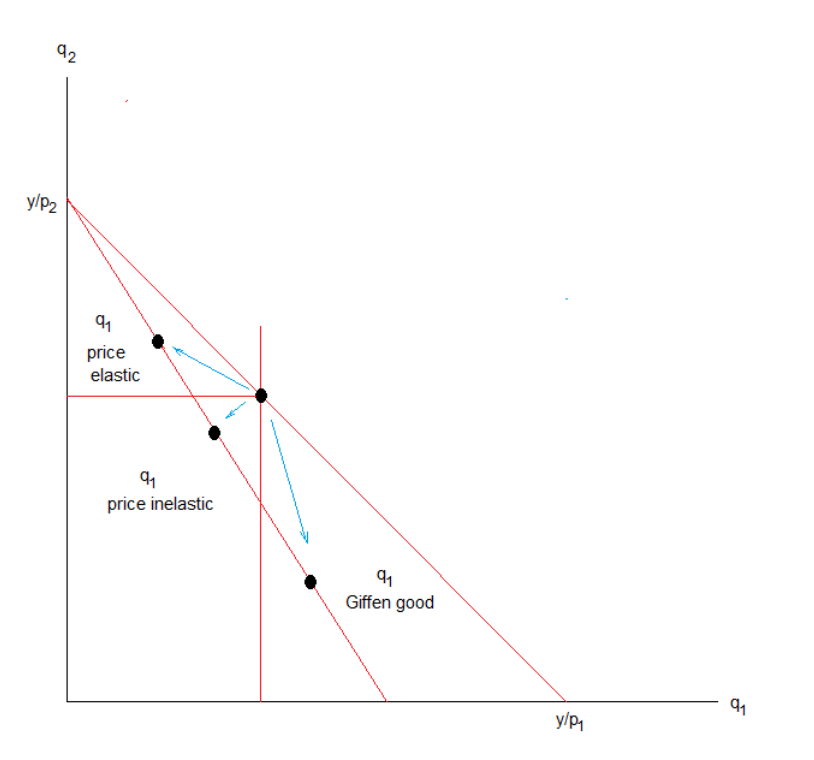
Price inelastic good (Draw an example of price increase and price elastic good)
The own-price elasticity is between -1 and 0. If budget share rises with price.
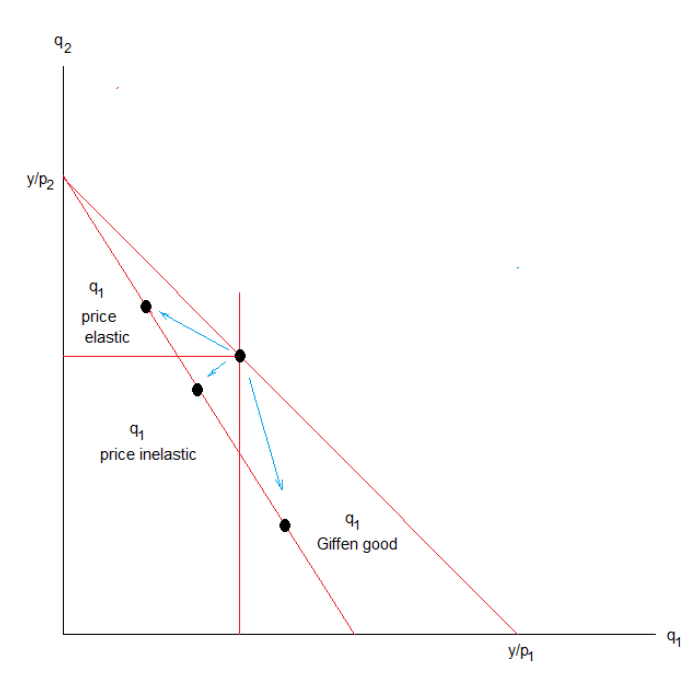
Cross price elasticity. Sign for complement/substitute?
Positive sign - substitute
Negative sign - complement
Engel aggregation (Derive)
What does the Engel aggregation imply?
Differentiate adding up wrt y
Rewrite as product of wage share and income elasticity by multiplying (y/q)(q/y)
Implies
Not all goods can be luxuries
Not all goods can be necessities
Not all goods can be inferior

Cournot aggregation (No need to derive, just state the implications)
Implies that when price of one good increases then purchases of some good (not necessarily that good) must DECREASE
WARP definition?
Weak axiom of revealed preferences
If bundle Qa is chosen when Qb is affordable, then Qb should never be chosen when Qa is cheaper
In the two good scenario, SARP violation implies…
WARP is violated
In the three or more good scenario … a violation of SARP implies…
Does not imply directly that WARP has been violated. SARP is stronger than WARP so if SARP is violated this doesn’t prove that WARP is violated. If however WARP is violated then yes SARP is violated
Law of Demand from Slutsky
If a good is shown to be normal, then df/dp must be negative if dg/dp is negative (→ dg/dp is always negative by negativity which only requires WARP)
Giffen Goods (Demand curve? WARP? When do we get them? INtuition?)
Demand curve is upward sloping
WARP satisfied
We get them even when the income effect is so strong that it dominates the substitution effect.
Intuition: Very poor communities where the price increase effectively restricts their consumption to just that inferior necessity good, forcing them to consume more of it (e.g. no longer able to afford meat, so they consume more rice)
IBC for intertemporal question (assume income y, assume no endowments nor profits)
c1 = (y0-c0)(1+r)+y1 if savings earn interest
c1 = y0 + y1 - c0(1+r) if savings dont earn interest
General eqbm definition
how is this diff from walras’ law
Zi = Sum(zih) = 0
Where zih is the excess demand of good i for household h.
Zi is the excess demand of good i for all households.
walras’ law: the value of agg. excess demand is zero. (Sum pZ = 0)
Walras’ Law (intuition? formula? what does it imply? and in the two-good mkt?)
Intuition: price*Aggregate demand equals price*Aggregate endowments. And so price*Aggregate excess demand = 0
→ Sum(pi*Zi) = 0 follows from aggregate excess demand times price = 0.
Implies there are only M − 1 independent equations determining M − 1 relative prices. Where M is the total number of goods.
Hence in the two-good mkt, general eqbm of one good (Zi = 0) implies the other good is also in eqbm (Zj = 0)
Draw the stable dynamics graph, relating relative price to excess demand.
When there is excess supply, what must happen to reach equilibrium?
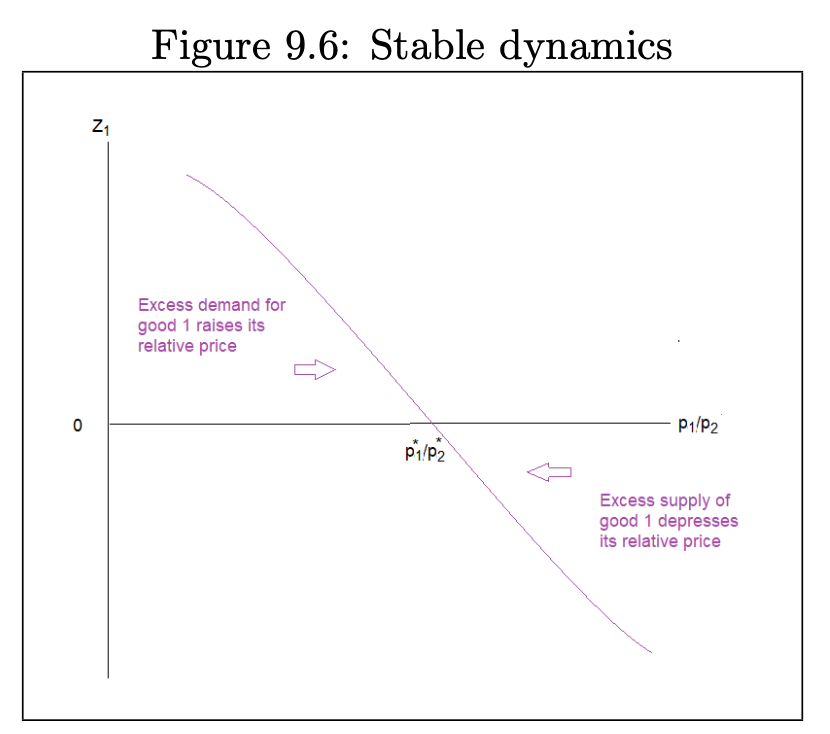
weakly preferred set (State the name of this set) of bundle qA
The upper contour set “R”
All bundles of qB which qB >~ qA
qB is at least as good as qA
weakly dispreferred set (State the name of this set) of bundle qA
The lower contour set “L”
All bundles of qB which qA >~ qB
qA is at least as good as qB
indifference set of qA
intersection of both “R” (Upper) and “L” (Lower) contour sets
all bundles of qB s.t. qB ~ qA
Completeness (Definition? How does it look visually on a map of q1 and q2)
There is no scenario where the consumer is unable to decide and does nothing. They either prefer one bundle over the other, or are indifferent between bundles.
In the map: Completeness means the sets L and R cover the whole space of the map (With the intersection being the indifference set)
Transitivity?
Draw an example of violation of transitivity side-by-side to adherence of transitivity
What’s a common preference criterion that violates transitivity?
Revealment of indirect preferences must hold. If qA >~ qB and qB >~ qC then it must be that qA >~ qC or else there will be a cycle
qA>~qB if qA1 > qB1 or qA2 > qB2 (Draw it out. Then a bundle qB that has more of good 1 but less of good 2 is both preferred and dispreferred to qA, which does not make sense. → a cycle)
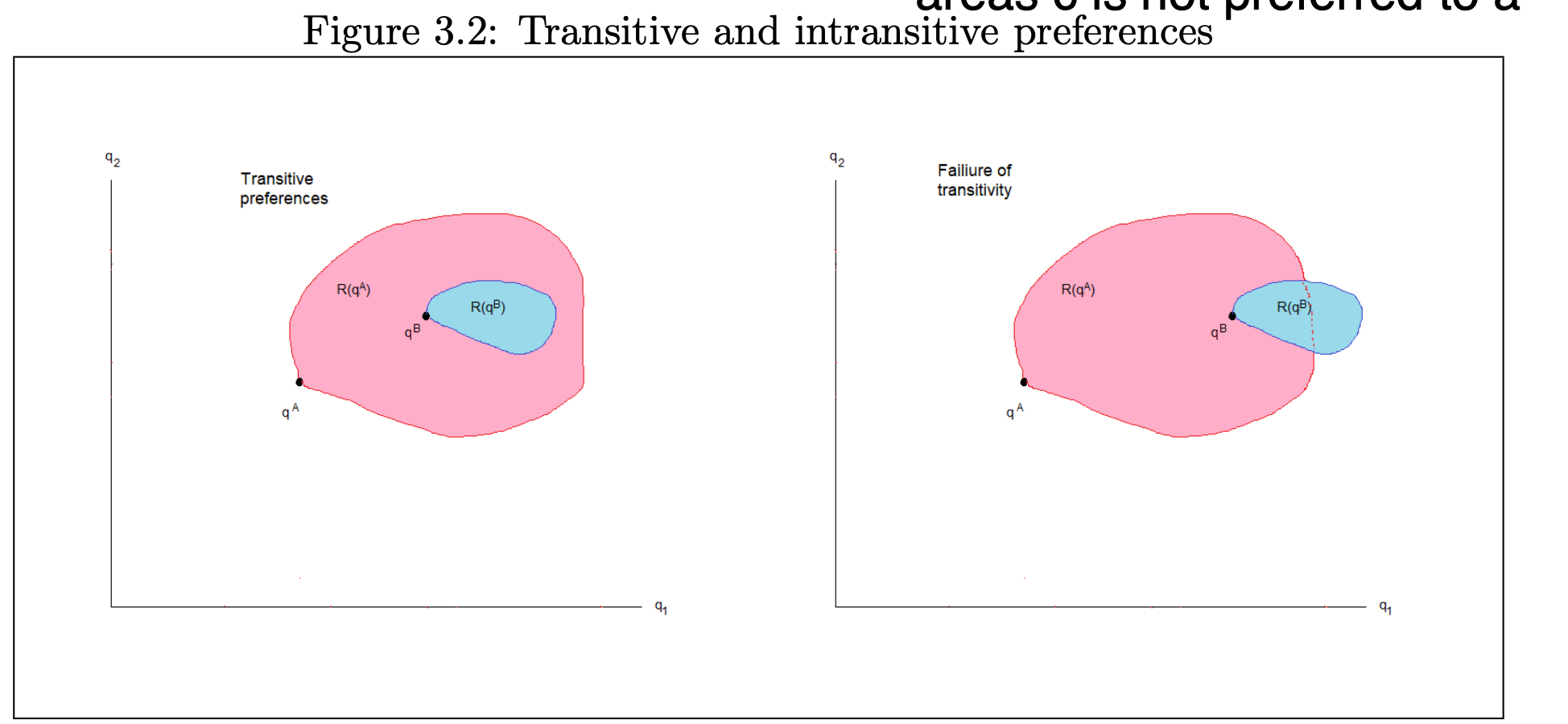
Preference ordering requires what conditions to hold?
Transitivity
Completeness
Nonsatiation
No bliss points
→ You can always move to a point that makes consumer better off
Monotonicity
ICs slope down, s.t. MRS is always negative
lexicographical preferences
(What does it violate)
qA >~ qB
If:
qA1 > qB1
OR
qA1 = qB1 and qA2 > qB2
Violates continuity because you can draw a line from A to C without crossing the indifference set of B.
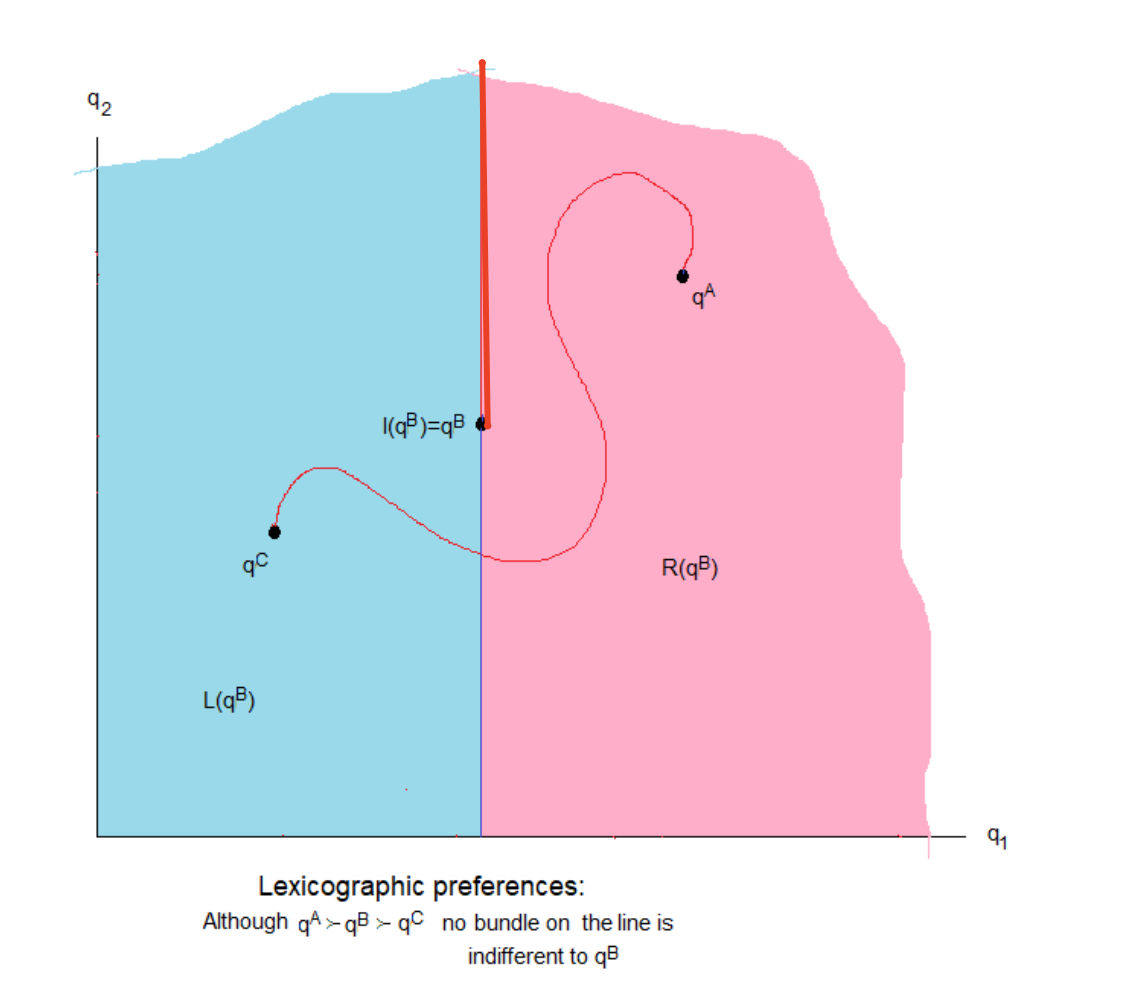
how to detect homotheticity given a cost function?
the utility in the cost function is multiplicative of a function of price
v*f(p)
example

how to detect luxury/necessity given a cost function
find the Hicksian, then find the budget share and see if it is increasing or decreasing in utility
SUPPOSE that bundle A is revealed directly preferred to B
yet bundle B is simultaneously revealed directly preferred to A
what preference rule does this violate?
transitivity
when might a consumer choose to consume none of a good, despite regular utility fxn
explain.
if quasilinear, wrt to good 1,
then if the budget is too low, then consumption of good 1 will be zero.
this comes from the fact that q2’s marshallian demand is always a fxn of just p, which is always positive. but q1 depends on y. so q1 may not always be positive.
Eqbm in production economies
What is the individual budget constraint?
Each firm tries to maximise profits = ykp’ = P*F(L) - w*L
Each individual owns a percent of the profits, theta. Sum of all theta = 1.
The individual budg constraint: p’qh = p’wh + sumkthetahk(p’yk)